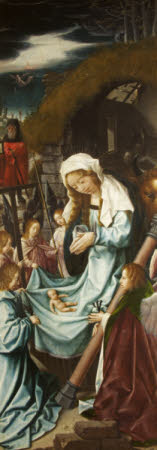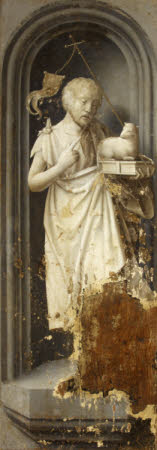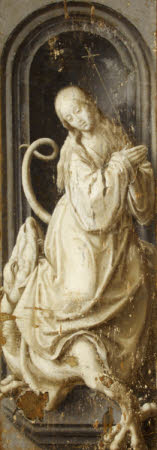Triptych of The Adoration of the Magi and Shepherds (centre) with The Annunciation (left wing) and The Madonna adoring the Christ Child (right wing) and Saint John the Baptist and Saint Margaret (closed)
Jan Provoost (Bergen c.1465 – Bruges 1529)
Category
Art / Oil paintings
Date
circa 1485 - 1529
Materials
Oil on canvas laid down on panel (centre); oil on panel (wings)
Measurements
864 x 711 mm (34 x 28 in)
Place of origin
Bruges
Order this imageCollection
Stourhead, Wiltshire
NT 730686
Caption
This is a religious altarpiece, or triptych because of its three parts. The Virgin, in white, and the Child, sit in front of a barn, with Joseph standing behind, whilst the three kings, or wise men, called Magi, who have travelled to Bethlehem to celebrate Christ’s birth, come to adore him. Caspar kneels, offering a gold chalice. The other two, Balthasar and Melchior, bearing their gifts of frankincense and myrrh, are standing. Balthasar points to the star which has guided them from the east, hence their exotic-looking clothing. It is said they represent three parts of the world: Europe, Africa and Asia. On the left wing is the Annunciation whereby the angel Gabriel, holding a fleur-de-lys sceptre, announces to the Virgin Mary that she shall conceive a son and call him Jesus. The lilies signify her purity. The inscription in gold lettering: Ave gracia plena domina tecom means Greetings most favoured one! The Lord is with you. A bolt of light representing the Holy Spirit enters through the window. On the right wing the Virgin, her hands folded in prayer, adores the newborn child by moonlight, accompanied by angels who carry the instruments of Christ's Passion, foreshadowing his death. On the reverse, with the wings closed, painted in monochrome (grisaille), are St John the Baptist and St Margaret.
Summary
Oil painting on panels and central panel transferred to canvas, Triptych of The Adoration of the Magi and Shepherds with The Annunciation (left wing) and The Madonna adoring the Child (right wing) (open) and Saint John the Baptist and Saint Margaret (closed) by Jan Provoost (Bergen c.1465 – Bruges 1529), a (possibly later) inscription in the Annunciation goes from the head (not the mouth) of Gabriel to the head of the Virgin, in Gothic script: Ave gracia plena dominna tecom [the mis-spelling of 'gratia' could indicate that this triptych was exported from Flanders to Spain]. In the central image, the Madonna and Child are seated in front of a barn with Saint Joseph standing behind them at the far right. The Madonna wears a dark blue robe covered by a white overmantel. Kneeling before Christ and his mother is Caspar, the eldest of the three kings (Magi) who travelled to Bethlehem to celebrate Christ's birth. Caspar wears sumptuous red robes and offers up a gold chalice. Standing behind a white dog at the left side of the panel are the two other kings, Melchior and Balthasar. Balthasar points upwards and to the right at the star which guided the kings to Bethlehem. Behind them, other figures can be identified as the shepherds who also came to worship the Christ child. Buildings, bridges and a view of the hillside above the town can be seen in the background. The Annunciation of the Virgin Mary is represented on the left wing of the triptych. The Virgin, wearing a blue dress and red cloak, sits before a pot of lilies. She is visited by the Angel Gabriel to her right, who holds a sceptre tipped with a fleur de lys in his right hand. Behind her a bolt of light representing the Holy Spirit enters through a window. A bed with green hangings can be seen in the background on the left. On the right wing of the triptych, the birth of Christ is represented as a moonlit scene with the Madonna, her hands folded in prayer, adoring the tiny child who is enveloped in the folds of her pale blue cloak. Behind her, angels wearing pink robes carry the instruments of Christ's Passion. On the reverse, with the wings closed, is a representation of Saint John the Baptist and Saint Margaret painted in grisaille.
Provenance
Presumably brought from Wavendon (listed as on the north side of the Picture Gallery in the 1898 inventory) by Sir Henry Hugh Arthur Hoare 6th Bt (1865 - 1947) and Alda Weston, Lady Hoare (d. 1947) between 1894 and 1898; given to the National Trust along with the house, its grounds, and the rest of contents by Sir Henry Hugh Arthur Hoare, 6th Bt (1865 – 1947) in 1946.
Credit line
Stourhead, The Hoare Collection (National Trust)
Marks and inscriptions
Recto - left panel: From head of Gabriel to head of Virgin: Ave gracia plena dominna tecom [sic]
Makers and roles
Jan Provoost (Bergen c.1465 – Bruges 1529), artist previously catalogued as attributed to Hans Memling (Seligenstadt 1430/40 – Bruges 1494), artist
References
Friedländer 1937: Max J. Friedländer, Die altniederländische malerei, 14 vols., Berlin and Leiden, 1924-37; trans. Early Netherlandish Painting, New York, 1967-76, vol. IX, 1931, no.124, p.145, pl.lxiv. Verhaegen 1958 N. Verhaegen, ‘Revers de volets peints révéles par Radiographie’, Bulletin de l’Institut Royal du Patrimonie Artistique, vol. I, 1958, pp.96–97 Stourhead, Wiltshire, 1975: [National Trust;Kenneth Woodbridge] 1975 , p.32-33 Stourhead List of Pictures [National Trust;Alastair Laing] revised and reprinted 1997, 2001, p. 17





